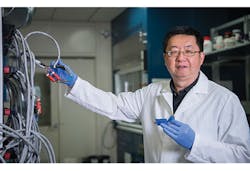For a Safer Li-ion Battery, Look to Salt Water
For the first time, researchers at the U.S. Army Research Laboratory and the University of Maryland have developed a lithium-ion battery that uses a salt-water solution as its electrolyte. It can put out 4 volts, making it useful for powering household electronics such as laptop computers, without the fire and explosive risks associated with some commercially available non-aqueous lithium-ion batteries.
“This technology will bring army personnel completely safe and flexible Li-ion battery that provides identical energy density as the SOA Li-ion batteries,” says Kang Xu, a scientist who specializes in electrochemistry and materials science at the Army Research Lab. “The battery will remain safe—without fire and explosion—even under severe mechanical abuses,"
Until now, high-energy Li-ion batteries meant a compromise on safety. And if you preferred safety, you would have to use an aqueous battery such as nickel/metal hydride, but you would have to settle for lower energy.
The research followed a 2015 study that resulted in a similar 3-V battery with an aqueous electrolyte, but was prevented from achieving higher voltages by the so-called “cathodic challenge.” This is due to one end of the battery, made from either graphite or lithium metal, being degraded by the aqueous electrolyte. To solve this problem, the Army team designed a gel polymer electrolyte coating that can be applied to the graphite or lithium anode.
This hydrophobic coating keeps water molecules away from the electrode and then, when the battery is first charged, it decomposes and forms a stable layer of breakdown products that separates the solid anode from the liquid electrolyte. This layer protects the anode from debilitating side reactions, letting the battery use more effective anode materials (such as graphite or lithium metal) and giving the battery reach better energy density and cycling ability. The gel coating also boosts the battery’s safety compared to standard non-aqueous lithium-ion batteries and boosts the energy density when compared to any other proposed aqueous lithium-ion batteries.
All aqueous lithium-ion batteries benefit from the non-flammability of water-based electrolytes, as opposed to the highly flammable organic solvents used in their non-aqueous counterparts. Unique to this one, however, is that even when the layer is damaged (if the battery casing were punctured, for instance), it reacts slowly with the lithium or lithiated graphite anode, preventing the smoking, fire, or explosion that might otherwise happen if the damaged battery brought the metal into direct contact with the electrolyte.
Though the power and energy density of the new battery are suitable for commercial applications currently served by more hazardous non-aqueous batteries, certain improvements would make it even more competitive. In particular, the researchers would like to increase the number of full-performance cycles the battery can complete and reduce material expenses where possible. Currently, the battery can handle 50 to 100 cycles, but to compare with organic electrolyte batteries, the team needs to get that to 500 or more cycles.
The researchers also note that the electrochemical manipulations behind the jump to four volts are important to future battery technologies. “This is the first time that we could stabilize really reactive anodes like graphite and lithium in aqueous media,” says Xu. “This opens a broad window into many different topics in electrochemistry, including sodium-ion batteries, lithium-sulfur batteries, multiple ion chemistries involving zinc and magnesium, and even electroplating and electrochemical synthesis.”
Xu says the interphase chemistry needs to be perfected before it can be commercialized. He also notes that more work needs to be done on scaling up the technology in big cells for testing. With enough funding, the 4-volt chemistry could be ready for commercializing in about five years, according to researchers.


